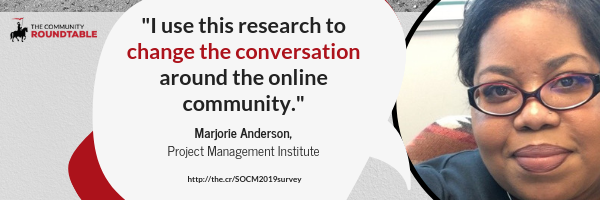Over the 10 years running The Community Roundtable, the community space has never been dull. Community programs still continue to struggle for visibility, attention, and resources despite years of effort.
A few years ago, the community conversation was somewhat limited in scope. Today everyone is talking about communities but it’s a lot less clear what people mean by it – and there is a lot more fragmentation of channels and tools. This represents new challenges. Now everyone seems to want community, but fewer understand what’s required to get it.
In short, community is having a moment. It’s up to community leaders to seize it – but we’ll need to make a compelling case – and we’ll need it backed up with data.
To that end, this year’s State of Community Management research is focused on three themes:
1. Community Leadership Comes of Age
It’s time for community professionals of all types to assert their leadership and help organizations understand the power, opportunity, challenges, and requirements of rich engagement.
Online community management is no longer a new discipline – it’s been around for decades. It is also merging with offline and real-world communities as digital becomes pervasive. Online communities have allowed us to better understand ALL communities because of the access we have to data at a scale not possible to achieve in offline communities.
That knowledge is now being leveraged to address complex challenges and opportunities in every industry – places we never imagined ten years ago – education, policy, and healthcare among them.
We need an updated profile of who community professionals are – at every level – including responsibilities, salary, reporting relationships, and career paths. This data will help us demonstrate that community professionals are no longer misunderstood or insignificant and, in fact, we have a sizable influence on our organizations.
2. The Community Market Diversifies
No community professional has to be told that there is more interest, more channels, more use cases, more platforms, more complexity… you no doubt feel it. On a daily basis, you field inquiries and requests from across your organization, from community members, and from executives. Those requests range from simple support questions to requests for training, coaching, or analysis.
You likely are not staffed for it.
The very nature of how people think about and define community is changing – sometimes in helpful ways and sometimes in confusing ways.
We need to quantify how community programs are changing so you can understand and communicate what is changing – and more importantly, its implications are for your organization and its strategy.
3. Mindsets Determine Community Success
Using a community approach is not for the faint of heart. People have minds of their own and they will tell you what they think. That is a GREAT thing if you have an abundance mindset – because any feedback indicates an opportunity. Those with scarcity mindsets, however, often see feedback as a threat to their control. Scarcity mindsets and their accompanying need for control – when exhibited by leaders or an entire culture – is the biggest barrier to community success.
This connection, however, is not well understood. We want to understand how this mindset correlates – or doesn’t with some of the other trends we see in hopes of identifying more areas to dig into.
Our 2019 research hopes to shed some light on how these mindsets are expressed and what the implications are.
Your Participation is Critical
All of this data matters to us as we make the case for our communities and communicate their power and value.
But the data doesn’t magically appear. We need it from those of you doing the work.
Please take the 25 minute survey: the.cr/SOCM2019survey

